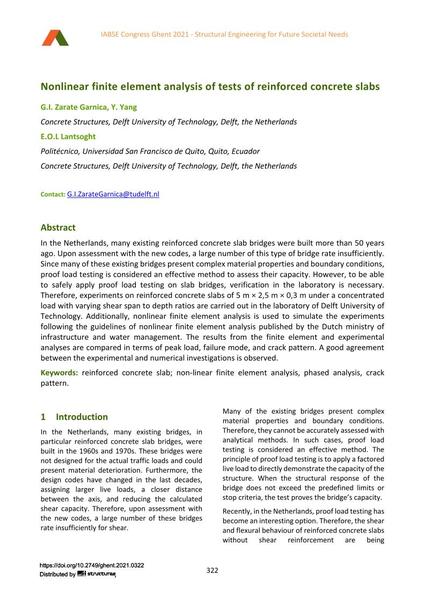Nonlinear finite element analysis of tests of reinforced concrete slabs

|
|
|||||||||||
Détails bibliographiques
| Auteur(s): |
G. I. Zarate Garnica
(Concrete Structures, Delft University of Technology, Delft, the Netherlands)
Y. Yang (Concrete Structures, Delft University of Technology, Delft, the Netherlands) E. O. L. Lantsoght (Politécnico, Universidad San Francisco de Quito, Quito, Ecuador; Concrete Structures, Delft University of Technology, Delft, the Netherlands) |
||||
|---|---|---|---|---|---|
| Médium: | papier de conférence | ||||
| Langue(s): | anglais | ||||
| Conférence: | IABSE Congress: Structural Engineering for Future Societal Needs, Ghent, Belgium, 22-24 September 2021 | ||||
| Publié dans: | IABSE Congress Ghent 2021 | ||||
|
|||||
| Page(s): | 322-330 | ||||
| Nombre total de pages (du PDF): | 9 | ||||
| DOI: | 10.2749/ghent.2021.0322 | ||||
| Abstrait: |
In the Netherlands, many existing reinforced concrete slab bridges were built more than 50 years ago. Upon assessment with the new codes, a large number of this type of bridge rate insufficiently. Since many of these existing bridges present complex material properties and boundary conditions, proof load testing is considered an effective method to assess their capacity. However, to be able to safely apply proof load testing on slab bridges, verification in the laboratory is necessary. Therefore, experiments on reinforced concrete slabs of 5 m × 2,5 m × 0,3 m under a concentrated load with varying shear span to depth ratios are carried out in the laboratory of Delft University of Technology. Additionally, nonlinear finite element analysis is used to simulate the experiments following the guidelines of nonlinear finite element analysis published by the Dutch ministry of infrastructure and water management. The results from the finite element and experimental analyses are compared in terms of peak load, failure mode, and crack pattern. A good agreement between the experimental and numerical investigations is observed. |
||||
| Copyright: | © 2021 International Association for Bridge and Structural Engineering (IABSE) | ||||
| License: | Cette oeuvre ne peut être utilisée sans la permission de l'auteur ou détenteur des droits. |
||||
